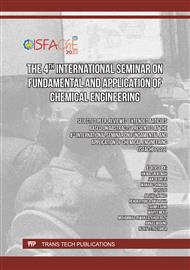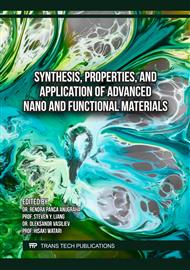[1]
M.P. Hochstein and S. Sudarman, "Monitoring of LUSI Mud-Volcano - a Geo-Pressured System, Java, Indonesia," Proc. World Geotherm. Congr., no. June 2006, p.25–29, 2010.
Google Scholar
[2]
B. G. S. Plumlee et al., "Preliminary Analytic al Results for a Mud Sample Collected from the LUSI Mud Volcano, Sidoarjo, East Java, Indonesia," 2008.
DOI: 10.3133/ofr20081019
Google Scholar
[3]
A. Mazzini, "10 years of Lusi eruption: Lessons learned from multidisciplinary studies (LUSI LAB)," Mar. Pet. Geol., vol. 90, no. December 2017, p.1–9, 2018.
DOI: 10.1016/j.marpetgeo.2017.12.025
Google Scholar
[4]
S. J. Suprapto, R. Gunradi, and Y. R. Ramli, "Geokimia Sebaran Unsur Logam Pada Endapan Lumpur Sidoarjo," Bul. Sumber Daya Geol., vol. 2, no. 2, p.4–13, 1970.
DOI: 10.47599/bsdg.v2i2.209
Google Scholar
[5]
H. T. Wibowo, B. Pratisho, C. Prasetyadi, and F. Yudiantoro, "Potensi Unsur Tanah Jarang (Rare Earth Elements) Di Lumpur Panas," p.533–539, 2022.
Google Scholar
[6]
R. Junaidi, A. Hasan, and M. Zamhari, "Karakteristik dan kalsinasi lumpur sidoarjo (lusi)," no. 1998, p.192–196, 2018.
Google Scholar
[7]
M.F. Nuruddin, R. Bayuaji, M. B. Masilamami, and T. R. Riyanto, "Sidoarjo Mud : A Potential Cement Replacement Material," vol. 12, no. 1, p.18–22, 2010.
Google Scholar
[8]
D. Hardjito, G. M. Wibowo, and D. Christianto, "Pozzolanic Activity Assessment of LUSI (LUmpur SIdoarjo) Mud in Semi High Volume Pozzolanic Mortar," vol. L, p.1654–1660, 2012.
DOI: 10.3390/ma5091654
Google Scholar
[9]
A.M. Abdel-rehim, "A new technique for extracting zirconium form Egyptian zircon concentrate," vol. 76, p.234–243, 2005.
DOI: 10.1016/j.minpro.2005.02.004
Google Scholar
[10]
W. Mayangsari et al., "DECOMPOSITION OF FERRONICKEL SLAG THROUGH ALKALI FUSION IN THE," vol. 12, p.5–7, 2021.
DOI: 10.15587/1729-4061.2021.217579
Google Scholar
[11]
S. Wu, L. Wang, L. Zhao, and P. Zhang, "Recovery of Rare Earth Elements from Phosphate Rock by Hydrometallurgical Processes - A Critical Review," p.1–111.
Google Scholar
[12]
R. P. N. Narayanan, N. K. Kazantzis, and M. H. Emmert, "Selective Process Steps for the Recovery of Scandium from Jamaican Bauxite Residue ( Red Mud )," 2017.
DOI: 10.1021/acssuschemeng.7b03968
Google Scholar
[13]
J. Liu, J. Song, T. Qi, C. Zhang, and J. Qu, "Controlling the formation of Na2ZrSiO5 in alkali fusion process for zirconium oxychloride production," Adv. Powder Technol., vol. 27, no. 1, p.1–8, 2016.
DOI: 10.1016/j.apt.2015.08.005
Google Scholar
[14]
A. Yustanti, F. A. F. Ode, and E. Sulistiyono, "Primary study of KOH alkali fusion – nitric acid leaching process in extraction of West Kalimantan zircon concentrate Primary study of KOH alkali fusion – nitric acid leaching process in extraction of West Kalimantan zircon concentrate," 2020.
DOI: 10.1088/1757-899X/763/1/012065
Google Scholar
[15]
A. B. Prasetyo et al., "Magnesium Extraction of Ferronickel Slag Processed by Alkali Fusion and Hydrochloric Acid Leaching," J. Min. Metall. Sect. B Metall., vol. 57, no. 2, p.225–233, 2021.
DOI: 10.2298/JMMB200224018P
Google Scholar
[16]
Y. Zhang, H. Li, and X. Yu, "Recovery of iron from cyanide tailings with reduction roasting – water leaching followed by magnetic separation ଝ," J. Hazard. Mater., vol. 213–214, p.167–174, 2012.
DOI: 10.1016/j.jhazmat.2012.01.076
Google Scholar
[17]
K. K. Windya, W. Wilopo, and F. Anggara, "KARAKTERISASI DAN PEMANFAATAN LUMPUR SIDOARJO UNTUK," no. December 2018, 2019.
DOI: 10.33536/jg.v6i3.242
Google Scholar
[18]
U. Hernawan and K. Budiono, "Karakteristik dan distribusi lumpur sidoarjo sepanjang sungai estuari dan perariran porong," Angew. Chemie Int. Ed. 6(11), 951–952., p.5–24, 1967.
DOI: 10.32693/jgk.11.2.2013.234
Google Scholar
[19]
A. Antoni, R. Geman, R. R. Tjondro, J. Anggono, and D. Hardjito, "Effects of calcination temperature of LUSI mud on the compressive strength of geopolymer mortar," Adv. Mater. Res., vol. 626, p.224–228, 2013.
DOI: 10.4028/www.scientific.net/AMR.626.224
Google Scholar
[20]
A. Susilo et al., "Coronavirus Disease 2019: Tinjauan Literatur Terkini," J. Penyakit Dalam Indones., vol. 7, no. 1, p.45, 2020.
DOI: 10.7454/jpdi.v7i1.415
Google Scholar
[21]
J. Pan, B. Vaziri, M. Rezaee, and C. Zhou, "Recovery of rare earth elements from coal fl y ash through sequential chemical roasting , water leaching , and acid leaching processes," J. Clean. Prod., vol. 284, p.124725, 2021.
DOI: 10.1016/j.jclepro.2020.124725
Google Scholar



